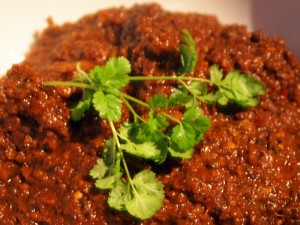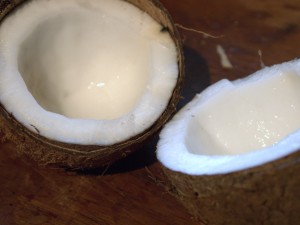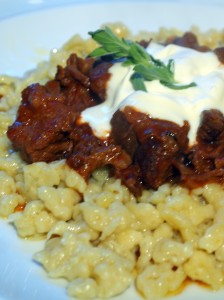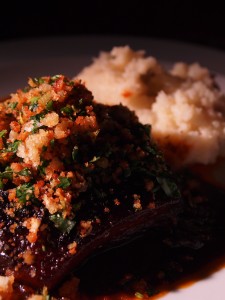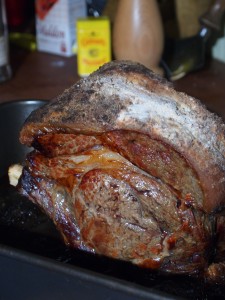
I’m blogging from my new MacBook Pro, an anniversary present from the inestimable Dr W. I’m still getting used to it; there are all kinds of PC keyboard shortcuts hard-wired into my brain that I’m having to relearn, and I don’t have any photo-editing software on here yet. In short, if anything looks a bit funny in today’s post, please be gentle with me – things should be better next week when I’ve got to grips with the various things the command button does!
Is there anybody out there who doesn’t love a big chunk of well-aged, grass-fed roast beef? This joint was a present from my in-laws, who have amazing taste in gifts. It’s from Lishman’s butcher’s in Ilkley, and had been sitting in the freezer for a few months, waiting for the weather to turn in a roasty direction.
If you’re not into turkey at Christmas, a beef rib is a fantastic substitution; it’s traditional but rather special, and there are very, very few Brits of a certain age out there who don’t have happy childhood memories of family occasions centred around a pre-BSE joint. To my mind, it’s the best of the roasting joints; the meat is rich and savoury from its proximity to the bone, and there’s a perfect amount of fat for lubrication and flavour in there. As a rule of thumb, you can count on each rib in the joint being sufficient to serve two people, so it’s easy to work out how large a chunk of meat to buy. I like to cook a rib nice and rare; if your uncle Bert likes his meat cooked until there’s not a trace of pink, just give him a slice from one end of the joint.
The gravy I served with this is a bit special; it’s intensely dense and savoury, and rich with the flavour of red wine and caramelised onion. Don’t use one of those undrinkable £3 bottles marketed as cooking wine here; while I don’t want you raiding the cellar for the Burgundy your Dad laid down in the 1980s, you should make this gravy with something you’d be happy to drink. If you can get hold of some real beef or veal stock made with a roasted bone, that’ll be fantastic here. The gravy has so much other flavour supporting it, though, that you can happily use some decent chicken stock instead. (And your freezer is full of home-made chicken stock, right?)
I served this with a huge, rustling pile of roast potatoes and parsnips, and a shredded spring cabbage sauteed in a little butter with some peeled chestnuts; these are all great for soaking up the gorgeous gravy. To roast a rib of beef rare (add five minutes per 500g if you want it medium, and ten if, for some unaccountable reason, you want it well-done), you’ll need:
Beef
A rib of beef
1 teaspoon salt
1 teaspoon mustard powder
1 teaspoon plain flour
Gravy
1 red onion
250ml red wine
1 tablespoon balsamic vinegar
300ml good beef or chicken stock
2 tablespoons plain flour
Juices from the joint
Salt and pepper to taste
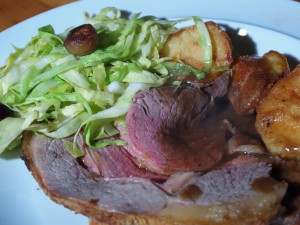
Take the beef out of the fridge in plenty of time, so it’s at room temperature when you come to cook it. Preheat the oven to a blistering 240ºC (460ºF). Pat the joint dry with kitchen paper. Mix the salt, flour and mustard in a small bowl, and use your fingers to rub the mixture all over the fatty surface of the joint.
Put the beef in a roasting dish and slide it into the oven for an initial 20 minutes, then bring the temperature down to 180ºC (360ºF) and cook the joint for 15 minutes per 500g. (See timings above for a medium or well-done roast.)
While the rib is cooking, start on the gravy. Slice the onion finely, and fry it in a little beef dripping (goose fat is good if you don’t have any) until it starts to brown. Tip the balsamic vinegar into the pan and cook, stirring, until the onions start caramelising and the mixture becomes sticky.
Pour the red wine over the onions and bring to a simmer. Add the stock, bring back up to a simmer and allow the whole thing to bubble away gently with the lid on for half an hour. Remove from the heat, and strain the contents of the pan through a sieve into a jug. Discard the onions, which will have given up all their flavour, and leave the jug to one side until the beef is finished.
When the beef is ready to come out of the oven, remove it from the roasting pan to a warmed dish in a warm place to rest for 20 minutes, covered loosely with a piece of tin foil. This will give you time to finish up the vegetables and finish the gravy while the muscle fibres in the meat relax and the juices start to flow. Finish the gravy by putting the roasting pan you cooked the meat in on the hob over a medium flame. Sprinkle the flour into the pan and use a whisk to blend it well with any flavour-carrying fat from the joint. Pour a ladle of the stock from the jug into the pan and whisk away until everything is well blended, scraping at the sticky bits on the bottom. Repeat, a ladle at a time, until everything is combined, then return to a saucepan and simmer away without a lid for five minutes, stirring as you go, before tasting to adjust for salt and pepper, and transferring to a gravy boat just in time to serve up the whole roast.

